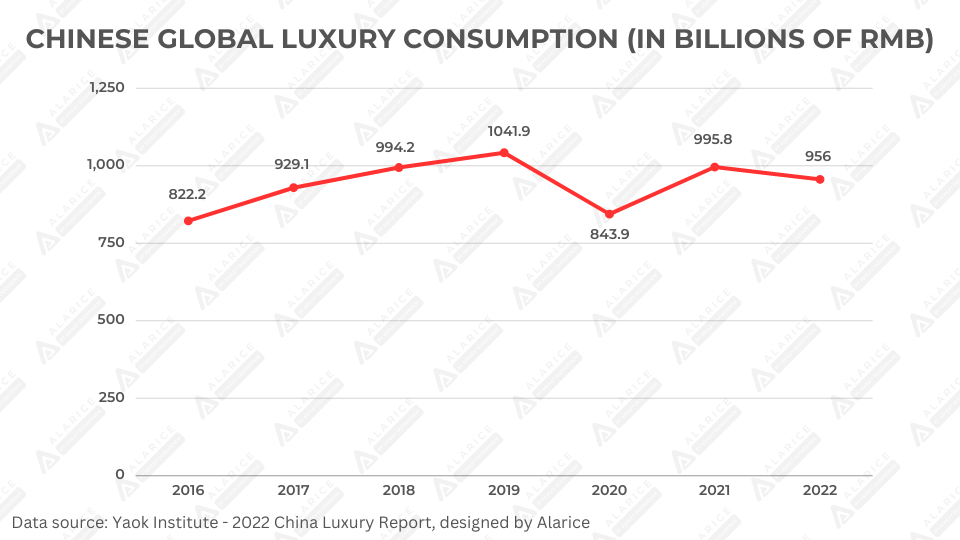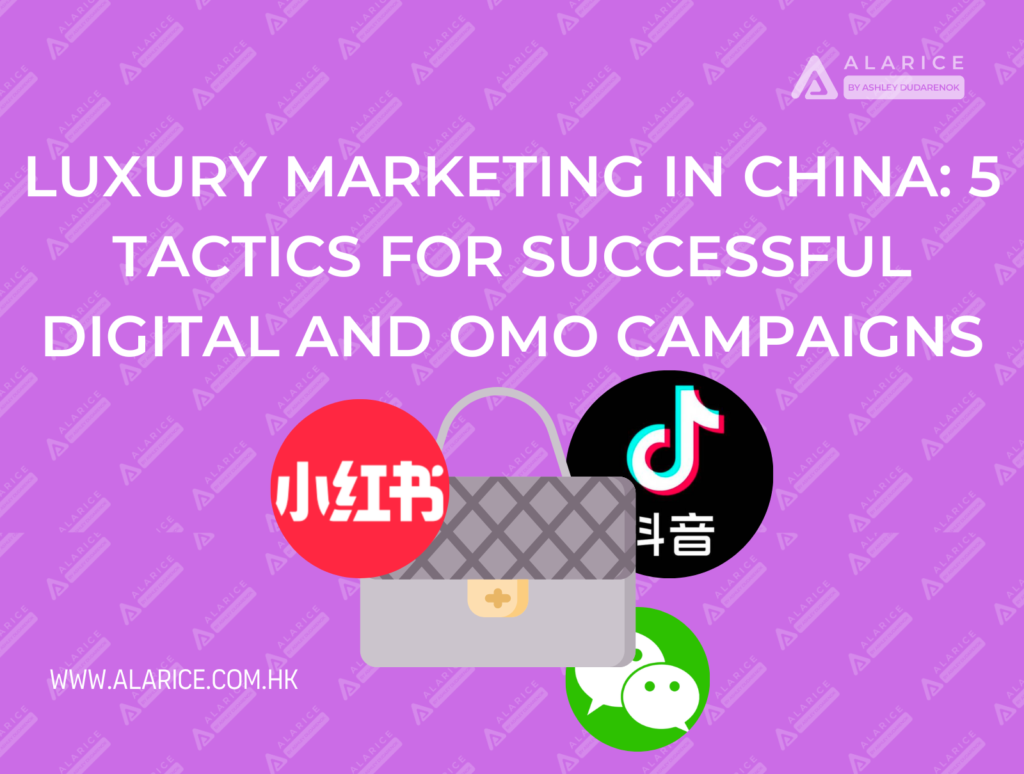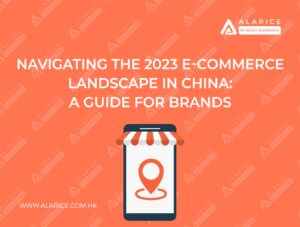Luxury is having its moment again.
Expensive, high-quality, rare products and services imbued with strong symbolic and emotional value are back. High status items that announce prestige and status are often featured in celebrity social media campaigns. Let’s take a closer look at what’s happening and the mechanics behind it all.
China’s Luxury Market
With the rapid development of China’s economy over the past few decades, it has become a major player when it comes to luxury consumption. According to Bain, the global luxury market fell by 20-22% in 2020 due to the pandemic. This was a return to 2015 levels.
Data from the Yoak Institute shows that in 2022, Chinese luxury sales declined by 4% compared to 2021 bringing in RMB 956 billion in revenue. Even with this small decline, China still made up 38% of the global luxury market, making it the most powerful market in global luxury consumption.

Data source: Yaok Institute – 2022 China Luxury Report
Bain & Company predicts that in 2023, as China gradually recovers from the pandemic and the legacy of the country’s strict Covid Zero policies, the luxury market will get back on track, and the market will be positive by the end of the first quarter. By 2030, the number of Chinese middle and high-income consumers is expected to double.
Some experts also believe that Chinese outbound shopping will gradually recover in 2023, but it will not be particularly obvious. In addition, a large number of high-end niche brands entered the Chinese luxury market in 2022, injecting new vitality into the Chinese luxury market.
Trends to Keep in Mind for 2023
New Customers and The Celebrity Lure
In addition to traditional luxury customers, there has been an influx of newly affluent people, who are prone to buying and consuming goods in order to attract immediate attention and flaunt their wealth. Recent studies have also shown that luxury brands aren’t limited to a few specific niche customer groups but are gradually being embraced by those who can only buy them occasionally.
Celebrities have long partnered with luxury brands and appeared in ads featuring luxury goods. This now extends to the digital and social media realms and has been changing the way brands promote products and engage customers. Celebrities, with their strong personal image, charisma and style, resonate strongly with conspicuous consumers.
Immersive and Metaversal
The metaverse is predicted to have a new breakthrough in 2023 so luxury brands should pay attention to digital and immersive online experiences in their marketing. In addition to establishing virtual IP, they can also trademarks and patent virtual brand creations.
Co-branding
Cooperations between luxury brands helps broaden their profile. This not only boosts sales and awareness swiftly, but also provides consumers with a more interesting product and marketing experience. Co-branding between well-known brands can attract wide attention, create new trends and stir up desire for valuable pieces.
Exploration and Self-expression
In the Global Consumer Trends 2023 report, self-expression features highly in shopping decisions. Consumers expect to be able to express their own personality and values through their products. Luxury brands need to understand what they represent to consumers and clearly communicate their brand philosophy.
National Pride and Localization
National pride and the attraction of vibrant domestic brands has long been a major concern for international brands. Localization is paramount and more than a trend. It brings a sense of meaning and belonging. Luxury brands must include local elements in new, exciting and unexpected ways.
Offline Campaigns as the Broader Economy Rebounds
The broader economy is expected to see a turnaround in 2023. The target audiences for luxury goods are very experience-oriented. Luxury brands can take this opportunity to plan offline branding campaigns to expand their brand voice and sales volume.
So, keeping all of that in mind, let’s look at how to launch effective celebrity campaigns.
5 Ideas and Tactics for Successful Digital and OMO Campaigns
1. Target Younger Consumers
Chinese luxury consumers have changed dramatically in recent years. Younger people are purchasing luxury items. They don’t get their ideas from traditional sources and are more inclusive and open-minded. To reach them, luxury brands need to have diversified and digital approaches, including social media.
Techniques like inviting popular celebrities to endorse items, sponsoring reality shows or TV series and integrating into other media that Chinese young people consume will expand the brand’s influence in the market.
For example, Gucci’s brand advocate Xiao Zhan was invited to Milan Fashion Week in 2023, which drew his fans’ attention and created greater impact.
2. Unique positioning and targeting
Prada’s creative campaign for the Year of the Tiger is a good example. They used Chinese cultural iconography in a way that appealed to the market. This was an example of a brand using localized elements well and integrating into the local market.
Luxury brands need to position themselves and target their campaigns well to establish a unique brand image while at the same time, appealing to the Chinese public. Some would say that using local cultural elements is more important than the product itself.
Celebrity endorsements must match this positioning and targeting. This can be a hard line to tread and, given the many celebrity scandals in recent years, must be done with an ever shrinking number of domestic figures.
3 . Create a big idea for a physical location
Coming up with a big, fun, attractive idea for a brand campaign is half of the battle, but with so many new and interesting concepts flooding the market, it’s hard to spark someone’s interest.
If you want consumers to pay attention to your idea, think of something concrete, rich and three-dimensional. Loewe and Howl’s Moving Castle collaborated on a campaign and attracted a large number of followers. In addition to their online launch, they also built an offline venue in Shenzhen and got a lot of attention.
Sometimes, castles can be stars.

Source: Loewe’s official Weibo account
4. Do a trial run beforehand
After planning, budgeting, choosing options and making timelines, do a mini trial run to see if there are any problems that can be ironed out and anything that can be further improved. Finding errors and fixing them early can save money, time and PR crises later so whenever possible, do a trial run.
For small events try to do a run through 1-3 days in advance. For large events, a month in advance is better.
5. Review the campaign in detail and make improvements for the next time
After the event, take a detailed look at it. Examine the presentation, main achievement highlights, comparison with previous campaigns or competitor campaigns and shortcomings. How was it received? What went well? What needed work?
A good summary report can help to fine tune positioning, plug any gaps and inspire the next campaign.
Implementing a successful luxury campaign requires creative ideas, careful planning, experienced implementation, seasoned professionals and more. Whether you want to expand your brand reach or do your first campaign in China, contact Alarice. We’ll create a personalized, tailored, professional solution for you.
References:
https://www.bain.com/insights/the-future-of-luxury-bouncing-back-from-covid-19/






